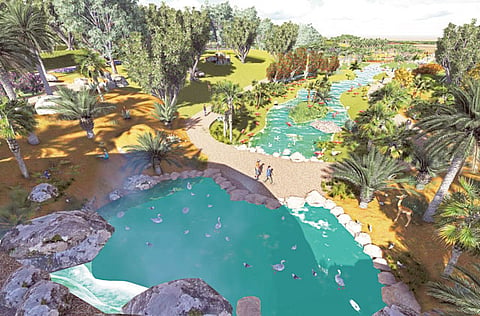Dh150 million Dubai Safari to showcase wildlife in natural setting
New multi-million dirham Dubai landmark expected to be completed by the end of 2014

Dubai: You might be forgiven for thinking that you have entered into foreign waters as you make your way through wadis filled with flamingos and animals running through greenery – this is the new Dubai Zoo.
Known as Dubai Safari, the Dh150 million park project is right on track and senior officials at Dubai Municipality have confirmed that the new Dubai landmark has completed its first phase of construction and, as scheduled, will be completed by the end of 2014.
The municipality has been carrying out excavation work since September 2012 and has been levelling the ground, as well as setting up the areas for internal and external roads. The Dubai Safari project covers 120 hectares that will consist of a zoo, safari and butterfly park, botanical garden, resort, and golf course, in addition to educational and veterinary facilities.
At 29 hectares, the zoo, which is located in Al Warqa area along Al Aweer Road opposite Dragon Mart, will replace the existing 1.5 hectare zoo in Jumeirah. It is expected to feature more than 1,000 animals and birds.
“Within two weeks, we will start carrying out the works for the infrastructure and work on the water feature package. The schedule is going according to plan and will be completed by the end of next year,” said Hussain Nassir Lootah, Director General of Dubai Municipality.
There will initially be 1,600 parking spaces over two designated areas and further down the line, the municipality intends to expand it to 3,600 parking spaces across 9.4 hectares.
“The first phase took time to complete because it used to be a landfill, so we had to clean and level the site. One of the other main challenges was designing the zoo because we had to keep in consideration the summer heat as it can get very hot between the months of May and September,” he said.
Lootah explained that some of the animals need to be kept in a controlled environment, and these buildings would use simple, water-cooled greenhouse technology. The buildings are envisioned to be large structures equipped with an artificial mud pathway with dense vegetation, which would reduce the temperatures for visitors moving between exhibits.
With the advice of a municipal zoologist and international specialists, Dubai Municipality was also able to choose what kind of animals would be chosen to live at Dubai Safari. For the animals’ consideration, the safari park will be closed at night so that they can rest peacefully.
The Safari will be divided into four different sections — African, Asian and Arabian Villages and an open safari — for animals coming from different geographical locations, with architecture and landscaping to match.
“Dubai Safari is a green project, which means that we have made it as sustainable as possible. Water will be the main element of the project, as a wadi and a waterfall will be built, and some of the villages will have boating activities,” he said.
Lootah pointed out that the municipality has taken power consumption into consideration and will incorporate various methods of energy conservation and energy- efficient designs, including solar power, water recycling, waste disposal and recycling.
“Various types of transport, which will run using solar energy, will be available to take visitors from one place to the other, and there will be a rubber wheeled tram and monorail capsules,” he added.
Sign up for the Daily Briefing
Get the latest news and updates straight to your inbox


